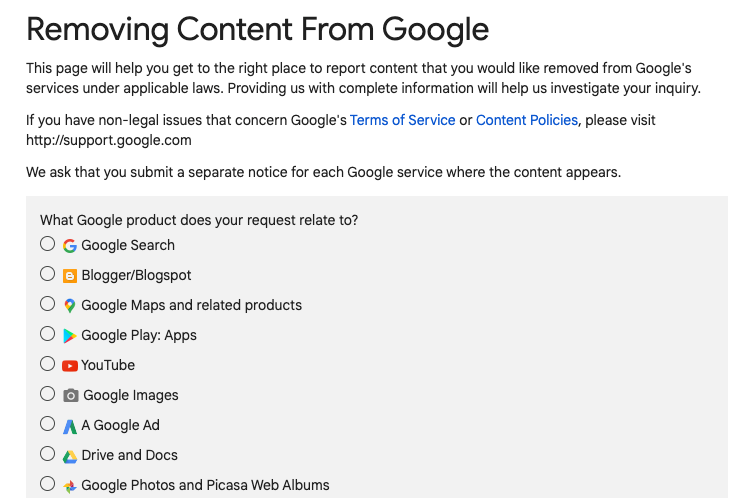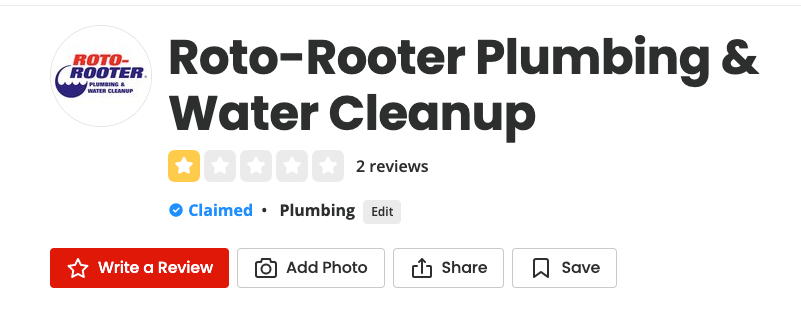Table of Contents
At Go Fish Digital, we’ve worked with a large variety of companies and individuals who are looking for digital reputation management. Through the years, we’ve come to realize that one of the challenging parts of repairing a reputation is knowing where to even begin. The Web is extremely vast and it can be difficult to get a grasp on where your brand’s reputation needs to be monitored and actively improved. To make this process easier, we developed a guide that outlines our process on identifying the source of the problem and steps we take to help brands repair their reputation.
Related Content:
- Online Reputation Management
- Online Reviews Management
- Search Suppression Services
- Yelp Review Management
1. Identify The Source Of Your Negative Reputation
The first step you should take in repairing your online reputation is to understand the source of what’s driving the negative sentiment. With so many different platforms and websites, you’ll need to narrow in on exactly where negative mentions of your brand or name are living. For instance, you might need to repair your reputation on an online review site or within the search results of a popular platform.
Here are the most popular sources you’ll want to review to understand where the negative sentiment is coming from:
- Google search results
- Yelp
- Glassdoor
- BBB
- Google reviews
If you’re not sure where to begin, go through each of the above platforms and start to look for information about your brand. Note the types of results you start to see and whether they have positive or negative sentiments. For any platforms where you witness a noticeable negative sentiment about your company, you’ll want to focus on repairing your reputation on that specific channel.
2. Remove Negative Results From Google
By far, the most common place we see that clients need online reputation repair is within the Google search results. This is because Google is the most popular information engine that exists. Google processes more than 8.5 billion searches per day. This means that it’s extremely common for users to perform research around brands they’re looking to use, people they’re considering hiring, what’s going on in the news and much more. Because of these factors, you need to be aware of what your brand’s presence is in the Google search results.
When searching for your brand, you’ll want to gain and understanding of your online reputation score. This is calculated by defining a sentiment for all the results in the first page and subtracting points for any negative articles that are appearing.
If you find that your online reputation score isn’t stellar, you might want to consider trying to remove negative results from Google.
While removing results is pretty difficult, there are steps you can take to achieve this. If you own the negative content, you could remove it from the search engines yourself. If the negative content has been written by journalists or other third parties, you could reach out to them and request that they take it down or use Google’s DMCA form to request removal. For a deeper look at how to do this, you can read our guide on how to remove negative search results.
3. Suppress Negative Search Results
Unfortunately, removing negative search results is exceptionally hard to do. Oftentimes journalists will refuse to remove their articles outright.
It’s equally as tough to get Google to completely remove content by using their DMCA requests. This can often be an extremely frustrating experience as there doesn’t appear to be any recourse to deal with the negative articles and repair your online reputation.
Suppressing the negative searches instead of outright removing them is most often the best approach. Suppressing negative search results occurs when steps are taken to improve the visibility of positive/neutral content ranking below the negative content. Over time, this pushes the negative content down the search results. Eventually the goal is to move the negative results completely off of the first page. While this takes more time and effort, this is often the most realistic solution.
For instance, here’s a screenshot of a client’s first page of Google when they first started working with us. The results are colored by sentiment (green:positive, blue:neutral, red:negative). At the time you can see that there were quite a few negative results.
However, over time we were able to suppress the negative results off of the first page of Google. The result was a much improved online reputation as users could only see positive URLs on the first page of Google.
Suppressing negative search results is completely possible but does require a good amount of effort. Some of the most common strategies that we use to suppress negative articles include:
- Optimizing existing owned positive/neutral content
- Creating new social profiles
- Creating new pages or websites about the target topic
- Creating backlinks to positive/neutral articles
By utilizing this process, we’ve been able to help many clients significantly reduce or completely eliminate negative content that appears on the first page. For more information, you can read out guide on how we suppress negative search results.
4. Remove Negative Reviews
Oftentimes, you’ll find that the Google search results are not the source of the issues. Instead, what we often see is that online reputation repair needs to be performed on individual review platforms. While this can certainly vary on a case by case basis, common platforms that cause reputation issues are Yelp, Glassdoor, TripAdvisor and Google Business reviews. These negative reviews can lead to poor overall scores on these review platforms.
As well, if users dive deeper, reading the individual reviews that users leave could further damage their online reputation.
These negative reviews can lead to users steering away from using the company and negative imprints of the brand’s reputation. In cases where your brand has accumulated negative reviews on platforms such as Yelp, you should consider steps to improve these in order to repair your online reputation.
If you’re seeing these types of reviews, the first step you can take is to report and flag any negative ones that violate the platform’s guidelines. Most platforms will have a set of guidelines that reviews will need to follow. If the negative review doesn’t follow these guidelines, you can flag it for removal. While these guidelines are unique to the individual platform, some common ways that reviews can go against guidelines include:
- Swearing
- Threats
- Conflicts of interest
- Reviews not related to the business
- Mentioning employees by name
For the platform where you’re having reputation issues, you’ll want to familiarize yourself with their review and content guidelines. From there, you can start requesting that any negative reviews be taken down. Over time, this should improve your review score while removing negative content from the platform.
To get a better idea on how this process works, we’ve created a video on how to flag reviews on the Yelp platform.
5. Encourage Positive Reviews
If you’ve identified reviews as the source of your online reputation issues, another step you can take is to proactively improve the number of positive reviews that you have from a given platform. This can help combat negative issues that already exist and cannot be removed by the review platform.
Below are some of the steps you can take to generate positive reviews:
- Encourage customers to leave positive reviews
- If the platform is filtering out positive reviews, take steps to remove the filter
- Request vendors leave positive reviews
- Utilize your CRM to request positive reviews from customers
- Identify common themes of negative reviews and address those internally
Before encouraging positive reviews, you’ll definitely want to familiarize yourself with each platform’s guidelines. However, even if the platform discourages the practice of encouraging reviews, this doesn’t mean that you shouldn’t do it. Your online reputation and brand sentiment are extremely important factors of your business’s customer experience and you should be taking steps to improve that where you can.
Taking these steps can help your brand turn the reviews of that platform around and improve your online reputation when users come across that page. For additional information, you can read our article on how to improve reviews for a multi-location business.
6. Monitor Your Brand Name
Another great step that you can take to repair your online reputation is being extremely proactive about monitoring mentions of your brand. If you’re a large company, chances are that there are continually new mentions of your brand getting posted online. Depending on the size of your brand, new mentions could be happening daily. Unfortunately, manually keeping tabs on all of the channels where your brand could be mentioned is near impossible.
Fortunately, there are quite a few tools that allow you to automate this process and notify you whenever your brand is mentioned across the Web. For instance, you can use tools like Google Alerts to send you an email any time a new article with your brand’s name is posted:
This can help you proactively monitor what’s being said about your company. This can be extremely powerful as it allows you to be more informed and can help you respond to any negative articles much faster.
Google Alerts will primarily track mentions of your name on other websites, but won’t monitor other platforms such as social media. If you want a better pulse on what’s being said about your company on platforms such as Facebook & Twitter than you can utilize social listening tools such as HootSuite to set up monitors for your brand name.
Overall, monitoring your company’s mentions has many other benefits than just awareness of your online reputation. Paying attention to this can give you better insights into what circles of the Internet your customers are spending time, their feedback on your service and products and potential link opportunities for your site.
Conclusion
While the task of repairing your online reputation can seem extremely daunting at first, hopefully this guide makes the process much more manageable. The primary things to keep in mind are to properly identify the sources of any negative brand sentiment and then take actions by removing or suppressing any negative content. As well, proactively creating new positive content such as new pages for the search engines to index or additional positive reviews can go a long way towards improving your brand’s reputation.
Tools & Companies To Help You Repair Your Online Reputation
If you’re looking to take steps to actively repair your online reputation, these are the tools and services that we recommend checking out.
- Go Fish Digital: We offer a variety of online reputation repair services including search suppression & review management.
- Ahrefs: Can monitor keyword rankings of your brand keywords
- Yelp Improvement Calculator: A tool to show you how many reviews you need to achieve a certain star rating on Yelp
- Google Alerts: Monitors mentions of your brand name across the Web
- HootSuite: Monitors mentions of your brand on social media
- Google DMCA Form: Can be used to request removal of content from Google
Search News Straight To Your Inbox
*Required
Join thousands of marketers to get the best search news in under 5 minutes. Get resources, tips and more with The Splash newsletter:





